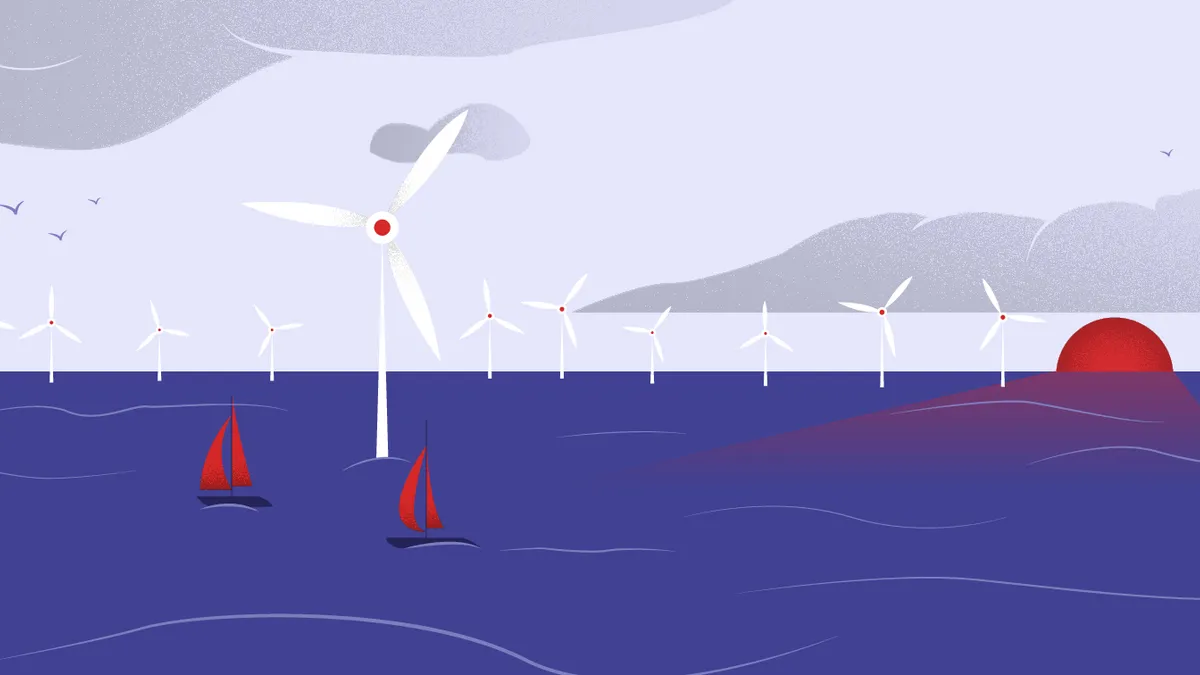Dive Brief:
- Vineyard Wind is rethinking its timeline for its offshore wind project off the coast of Massachusetts, announcing on Tuesday that the project will not be in commercial operation in 2022 as previously anticipated, in response to an updated permitting timeline from the Bureau of Ocean Energy Management (BOEM).
- BOEM officially issued revisions to its process on Friday, aiming to issue the final Environmental Impact Statement (EIS) on the project on Nov. 13, and a final decision on Dec. 18. The EIS is needed before a project can begin construction in federal waters.
- The developer had previously committed to its original deadline despite permitting delays from BOEM, saying they were built into the 800 MW project's timeline — BOEM's previous permitting timeline would have led to a final EIS by June 7, 2019. According to a spokesperson, the company needs more time to analyze construction estimates given the new timeline.
Dive Insight:
Vineyard Wind needed to begin construction by the end of this year to qualify for the federal production tax credit. The Massachusetts Department of Public Utilities had approved a 20-year contract for about $0.089/kWh between the project's two phases. To meet such low costs, Vineyard pursued any opportunities to lower project costs, from timely construction to bidding energy into the ISO-New England forward capacity market.
Another offshore wind project, Mayflower Wind, was also awarded a contract with Massachusetts and planned to begin construction this year, to qualify for the tax credit.
"We do not expect the Vineyard timeline to negatively impact our project at this time," Mayflower Wind President John Hartnett said in a statement, adding that the joint venture has monitored BOEM's timeline in reviewing Vineyard Wind's project.
The nascent offshore wind industry in the U.S. has been watching Vineyard, the first large-scale project to undergo permitting, closely. Previous delays on the project were referred to as the industry "growing through operational issues," Mark Mitchell, Dominion Energy's vice president of generation construction, had formerly told Utility Dive.
Dominion is pursuing its own large-scale offshore-wind project, working with Ørsted, separate from the Vineyard project. Dominion's generation arm had amended and re-issued the research activity plan for its 12 MW offshore wind pilot following BOEM's rejection of Vineyard in 2019, but Dominion declined to comment on BOEM's timeline changes for the Massachusetts large-scale offshore wind project.
BOEM granted the first federal permits for offshore wind to Dominion and Ørsted's Virginia pilot in October 2019.
With the new timeline, BOEM issued a new milestone in its permitting process for Vineyard Wind set almost a year after the project was supposed to receive its EIS, to publish an EIS supplement that takes into account the build out of the resource. This aspect of the permitting process will address a robust analysis of the cumulative impacts of offshore wind build out that stakeholders and cooperating agencies had requested of the Vineyard project.
The initial draft EIS did not analyze the project in the context of the "greater build out of offshore wind capacity that is more reasonably foreseeable" today, BOEM wrote online.
"[S]tates and industry players continue to be on the lookout for BOEM's determination of the scope of its cumulative impact analysis, which need not but nevertheless may even further delay issuance of additional wind energy areas for lease," Noah Shaw, partner and co-chair of Hodgson Ross' renewable energy practice, told Utility Dive.
BOEM will approve the construction and operations plans of the project no later than 90 days after it will issue a "record of decision" on Dec. 18, 2020, initially expected on August 16, 2019. Other permits will also be issued for final approval following the EIS decision, including the Clean Water Act permit.
The new timetable provides "important clarity" for the U.S. offshore wind industry, Laura Morton, policy and regulatory affairs senior director for the American Wind Energy Association, said in a statement. "Moving forward, it's critical Interior meet or accelerate the announced schedule, expedite the review for other offshore wind projects under development, and move forward with auctions for new wind energy lease areas, which will create thousands of new jobs and economic opportunities nationwide."
“While these further delays from BOEM are concerning and, frankly, difficult to justify, states continue to press ahead with procurements and developers continue to invest in the U.S. market," Shaw said.
Despite disappointments over the permitting delays from within the Interior Department, the U.S. offshore wind industry received good news from the Trump administration's proposed FY2021 budget, which earmarked a $5 million increase for offshore renewable energy within BOEM, for a total of $26.5 million.















